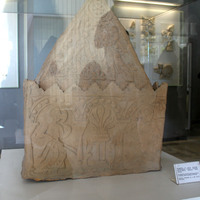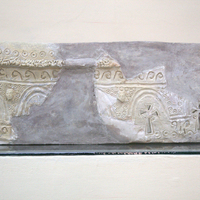Sogdian ossuaries
Type:
Ossuaries
Date:
Fifth to seventh century
Location or Findspot (Modern-Day Country):
Uzbekistan
Medium:
Earthenware,
Terra-cotta
Dimensions:
75 × 52 × 24 cm (ossuary from Mulla Kurgan)
Description:
The Sogdians did not practice inhumation (burial of the dead) because of the Zoroastrian belief that doing so would pollute the earth. Instead, they practiced excarnation (defleshing), most often by leaving a body to be consumed by carrion-eating dogs or birds before putting the remaining bones in an ossuary. Like certain Christian reliquaries in the shapes of miniature structures, a baked-clay ossuary (seventh century) found at Mulla Kurgan (Uzbekistan) takes the form of a small fire temple in which ritually pure priests tend to the sacred fire. They protect the fires from the contaminating effects of their breath by wearing face coverings. The women dancing on the pyramidal lid may represent "pleasure givers" dwelling in the afterlife or mourners at a funeral.
Many Sogdian ossuaries have nonfigural decoration, including arcades and crosses. It is likely that Central Asia saw Christian missionary activity by the fourth century, but whether these crosses had Christian significance or were decorative patterns, like the incised circles and heads in the spandrels, is unknown.
Many Sogdian ossuaries have nonfigural decoration, including arcades and crosses. It is likely that Central Asia saw Christian missionary activity by the fourth century, but whether these crosses had Christian significance or were decorative patterns, like the incised circles and heads in the spandrels, is unknown.
Relevant Textbook Chapter(s):
3
Repository and Online Resources:
• See additional photos and read more about the Mulla Kurgan ossuary on the website of the Freer Gallery of Art and Arthur M. Sackler Gallery, Smithsonian Institution.
Image Credits:
Wikimedia Commons; Linda Safran




